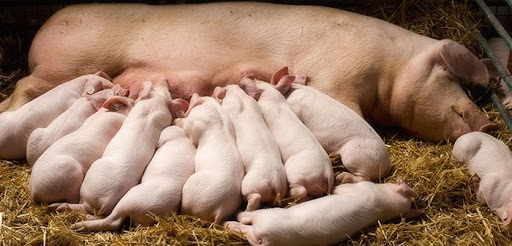

We all hope that things go quietly and easily for our sows when they’re farrowing. But what about when things aren’t going quite as they should? We’ve spent some time discussing how to lower piglet mortality rates before, during and after farrowing in normal situations. Though a sow needs help in under 1% of farrowings, it’s better to know what to do beforehand so that you can do what’s needed to take care of your sow.
Signs of farrowing problems
What are some signs that farrowing is not going as expected? If the pregnancy lasts over 116 days, the sow is off her feed, has bloody fluid and meconium without straining signs, strains with no result, has over an hour between piglets and the sow still has babies in her, smelly brownish grey discharge, the sows eyes are red, she is exhausted after a long labor or is starting into shock with weakness, fast breathing and is unable to get up.
Performing an internal exam
You need to be very gentle in this, as damage to the birth canal causes swelling, heavy bleading and possible death of both the sow and her piglets. To examine the sow, make sure you’re familiar with the basic layout of a sow’s reproductive system. Clean her rectal and vaginal area very well with soap and water, possibly including a quick iodine wash or spray of hydrogen peroxide. The assistant’s fingernails should be cut short and filed lightly to remove sharp edges, then wash their hand and arm, put an OB glove and and use a lubricant. Cupping the hand into a cone shape, the hand is gently inserted into the birth canal. If the sow is not ready for farrowing, the part further in will be closed up. The uterus slopes downward and has two horns, one to each side. Once you’re in, the problem should be corrected if possible, whether it’s turning a piglet, finding tears that will require veterinary involvement or other issues.
Possible issues
Improper presentation is caused by a breech, a piglet being upside down or two piglets trying to enter the birth canal at the same time. Manipulate the piglet(s) into the proper position and allow the birth to proceed.
If the birth canal is obstructed, it can be caused by a number of issues. Hymen constriction can happen in gilts, requiring manual dilation or severing it with scissors.
Constipation or a full bladder can also cause issues, which may be remedied in the first issue by giving a warm soap water enema or manually removing the impacted matter (this is why you should make sure the sow exercises at least 10-15 minutes daily before farrowing).
In the second issue, exercise may help relieve the issue or give oxytocin. In rare instances, a veterinarian may need to insert a cathater to relieve the pressure.
Uterine inertia is what happens during long deliveries when the uterine stops contracting. Your best bet is to enter the birth canal and remove as many of the piglets as you can reach using a snare or their snout to guide them out.
If the sow is panicking, provide a tranquilizer as recommended by your vet, give oxytocin to finish the process more quickly and remove the piglets until the sow has quieted down and is done farrowing.
When to call the vet
In the case of a vaginal or cervical prolapse or a too small pelvis, it is vital that you call your veterinarian immediately for treatment. If the uterus is twisting, the pig is too large, the placenta is retained or there is blood or pus in the discharge, there is a prolapse of the birth canal, uterus or bladder or a hemorrhage occurs, call the vet immediately.
 Contact Jaguza Support
Contact Jaguza Support